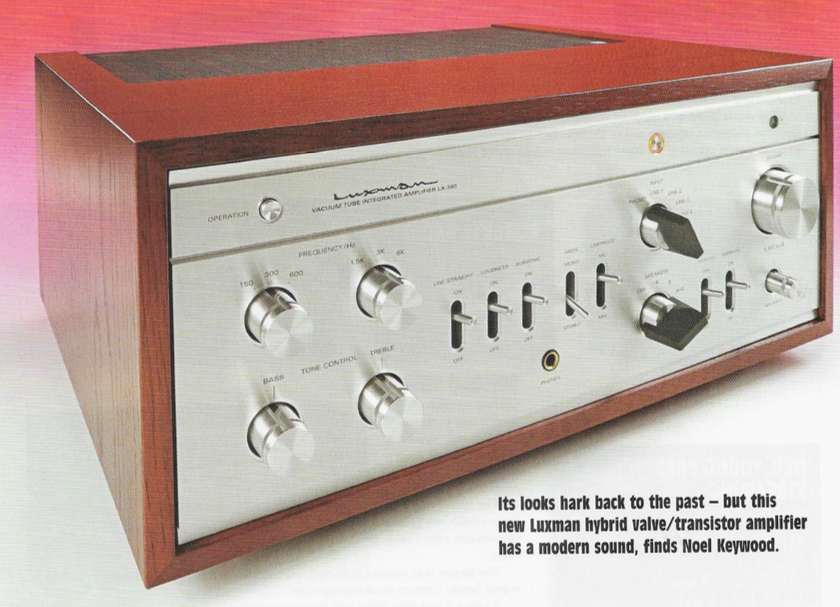
They don’t make’em like they used to – until you see the new Luxman LX-380 valve amplifier from Japan that I’m reviewing here. Japan went down the nostalgia road somewhat before the UK and this new amplifier mines Japan’s not-so-distant past beautifully. It doesn’t just look good, it feels solidly hewn and its controls are delicious to use. Luxman always produced great products – I’ve owned many and this amplifier gets right back to the qualities that attracted me and so many others decades ago.
The LX-380 is not quite pure though: it is a hybrid.The preamplifier stages are solid-state; only the power amplifier is valve (tube) equipped, using 6L6GCs. These are compact tetrodes considered good for 30 Watts in guitar amplifiers where overload is tolerated, but for around 20 Watts in everyday audio use where long life from lower anode volts is preferred – and indeed Lux make this point in their user manual, “operating conditions of the output tubes having some allowance“ they say.
So the LX-380 delivers 20 Watts per channel. It may seem feeble against the 100 Watts or more we expect nowadays, but in conjunction with sensitive floorstanding loudspeakers (90dB from 1 Watt) it is more than enough for very high volume. If you don’t want to wake the dead then it will drive smaller loudspeakers nicely too but I’d recommend large standmounters as a minimum for reasonably high volume coupled with strong bass.
I’ve seen worries about the unreliability of valve amplifiers, the expense of running them and what have you.Yes, power output valves do need replacement after a few thousand hours of use but 6L6GCs are plentiful and around £42 for a matched pair -not a king’s ransom. Expect around 3 years for three hours of use per day, every day – heavy going. Auto-bias makes bias adjustment unnecessary.
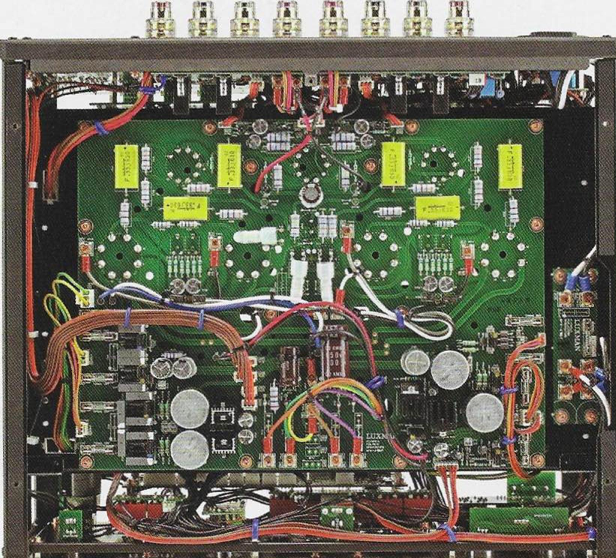
The LX-380 is very user friendly then: it is what it looks, an everyday integrated amplifier, built to standards long gone and with a sound only valves can give – easy going, free from transistor fatigue and with a capacious soundstage. The tubes are hidden and heat output is moderate, so everyone -including the cat – is safe.
Like any self-respecting valve amplifier the LX-380 is heavy, weighting 17.6 kg (39lbs). But it doesn’t take up a lot of space, measuring 440mm (17.3in) wide, 403mm (16in) deep and 197mm (7.8in) high. Most of the weight lies in the two output and one mains transformer but the case is solidly built and Luxman don’t skimp, using a chunky machined alloy fascia with a superb standard of finish.The control knobs and switches are likewise solid machined alloy, having beautifully smooth yet silent actions. I should mention that Luxman advise space be left around the unit for heat dispersal; I’d suggest 6in (15cms) or so above.
Although the volume control looks like a conventional motor driven (remote control) Alps, in fact it is an electronic attenuator with discrete resistors selected by relays operated from a normal volume potentiometer. This gives the feel of a volume control and allows a motor to be used to rotate the knob by remote control.
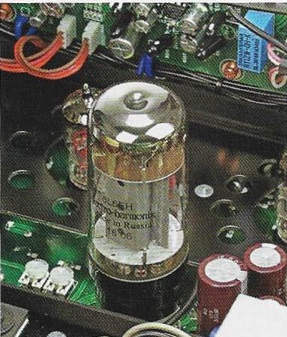
Such a system has the accuracy and quality of a resistive attenuator, including its immunity to overload, whilst also ensuring frequency response is unaffected by volume control position, as it unfortunately can be when a conventional volume control is used in a poorly designed circuit. To do this you must use logic to switch the relays – it is a complex but very purist way of changing volume.
Clever stuff then – electronically sophisticated and expensive to produce – but effective in theory and in practice our measurements showed. The volume control of the LX-380 is a great piece of modern audio engineering in an amplifier that’s seemingly old by looks.This well illustrates what Luxman are offering here: the best of today with the best of yesterday. The past brought up to date.
Like all Luxman amplifiers this one carries a wealth of facilities. It has four Line inputs to accept CD, DVD players and what have you.They are very sensitive, suiting low output devices like low gain external phono stages and old portable players or analogue tuners with low output.
There is a phono stage for LP, front panel switched to suit MM or MC cartridges.The entire preamplifier is solid-state so you don*c
get valves here.
Unlike most modern amplifiers this one has Record Out and Monitor input RCA (phono) sockets to handle externa! open-reel recorders, or cassette decks – a real blast from the past! The valve power amplifier can be accessed direct from Main In sockets – useful for today’s portable players and DACs that have their own volume control and high output (IV or more).
Like amplifiers of yore, there are Bass and Treble tone controls, here with switched turnover frequencies. This makes fine adjustment of frequency extremes possible – great for subtly tailoring the sound of connected loudspeakers. In true audiophile fashion the tone control circuitry can be switched out with a Line Straight lever switch.
The front panel switches and controls do not appear to switch directly: rather they actuate relays, so there was a small kerfuffle when I flicked a lever, because this initiates mute/relay/unmute sequences.You get longer life and better sound quality over that life with this approach but not the instantaneous response of switching direct.
A solidly carved remote control unit alters volume and has a Mute function but does not select input or the other controls and has no On/ Off function.
The rear panel carries two pairs of *speaker sockets, for A and B loudspeaker pairs. Front panel switching selects A, B, or A +B together.
The rear panel carries chunky modern loudspeaker terminals – no sign of the horrible spring clips or shaky screw terminals of the past that allowed shorts and tarnished quickly.They accept spades, 4mm banana plugs or bare wires. All other inputs are unbalanced through the usual RCA type phono sockets; there are no balanced XLR connectors.
Internally there is one protection fuse within the mains transformer primary circuit but none in the secondary HT lines, to protect the output transformer primaries in event of tube failure – something I consider important. Since fuses and fuse holders are cheap I am surprised at this.
SOUND QUALITY
The Luxman sounded unhappy driving our in-house reference Martin Logan ESL-X hybrid electrostatic loudspeakers: bass was limited. This surprised me because valve amps like our Icon Audio Stereo 30SE (30W) are a perfect match.
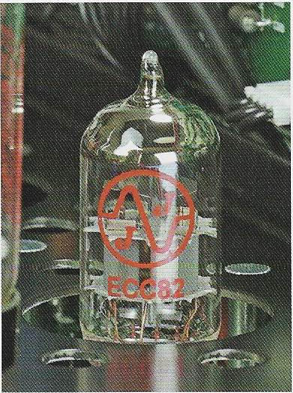
Contrarily,PMC’s twenty5.24 loudspeakers were a match made in heaven.The PMCs have obvious and well-extended bass as well as strong treble with a smooth and easy midband. This did not just suit the LX-380 but the two sounded fabulous together. This does suggest however that the LX-380’s limited bass power of 8 Watts (see Measured Performance) needs to be understandingly accommodated Loudspeaker matching is an issue but I believe it will suit most conventional floorstanders.
Digital was fed in from an Oppo BDP-205D Universal disc player, meaning CD and hi-res from an optically attached Astell&Kern AK120 portable player. For LP I used our in-house reference Timestep Evo modified Technics SL-1210 Mk2 turntable with improved control circuits and linear external power supply, carrying an SME309 arm with Audio Technica VM750SH MM cartridge and, alternatively, an Ortofon Cadenza Bronze MC cartridge to assess both MM and MC inputs.
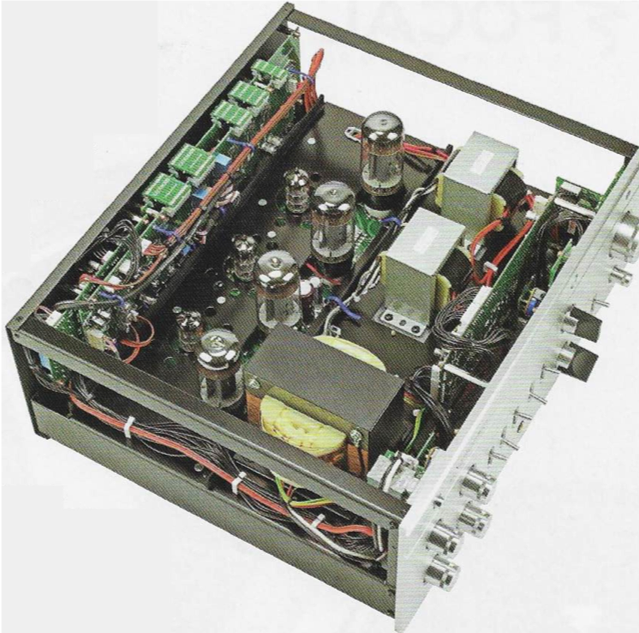
Spinning Josefine Cronholm’s ’In Your Wild Garden’(CD) the reason for buying a valve amplifier was thrown at me: her voice had enormous contrast against a silent background that made for a feeling of great dynamic power.
“There was ease of deIivery, a fluidity of event that makes for a lifelike presentation free of the mechanical sound from transistors.”
Valve amplifiers do this,they have seemingly muscular delivery that suggests primary feedback taps.
The result was an utterly gorgeous sound, vocalists having a lovely rounded presence and lively nature. Treble was as sweet as I could hope for, the emphasis of the PMC’s being reasonably obvious at times, but also contributing to conspicuous and precise stereo images across the sound stage.
The Berliner Philharmoniker playing Strauss ‘Don Quixote’ (24/96) stretched wide and filled our large listening room, massed horns having a lovely brassy quality and plenty of dynamic push. But when all fell silent for a solo violin the Luxman tracked this change beautifully, conveying its emotional impact in full.
Whatever I played, digital from the Oppo was graced by the Luxman^ signature sound – but so too was analogue from LP after switching from Line 1 to Phono and pressing the Technics On button. With Audio Technical VM750SH MM cartridge the bass line behind Mark Knopfler’s ’Madame Geneva’ was firm, expressive and easy to follow via the PMC loudspeakers.The whole delivery was liquidly smooth, atmospherically spacious and a performance to wallow in.
At high volume there was no hiss or hum, LP sounding as deeply silent as CD. I swapped the VM750SH for our Ortofon Cadenza Bronze MC cartridge and flicked the front panel lever switch to MC (no clicks or thumps).
Again, there was virtually no hiss and plenty of available gain – so no apparent matching problem. But the Cadenza was less glassy up top and a tad more amenable and considerably more powerful in its bass.
The reggae-like bass line of Dire Straits ‘Ride Across the River’ was expressed superbly well, sounding strong, deep and articulate. So in spite of poor measured figures I heard a great result here.The PMC’s give strong bass without drawing bass current and this suited the LX-380 perfectly.
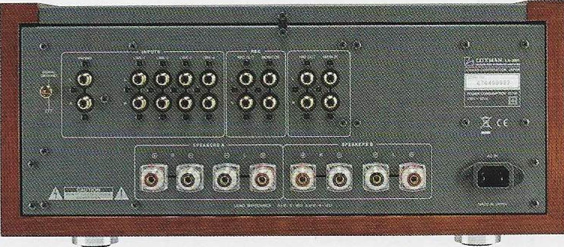
CONCLUSION
They don’t make like they used to: in the LX-380 they now make ‘em better.You pay for this sort of quality and attention to detail but Luxman amplifiers always were more expensive than the herd.They have to be with all the facilities that come included.With ourTimestep Evo updatedTechnics SL1210 Mk2 turntable and a new Audio Technica VM750SH MM cartridge, spinning LP in particular brought past wonders back to life in entirely modern form, giving a luscious sound. So if you hanker after an easy to use amplifier built the way they were – with no digital in sight – the new LX-380 from Luxman is a must. Just use it with suitable loudspeakers to ensure strong bass.
MEASURED PERFORMANCE
The 6L6GC power amplifier output stage is quoted at 20 Watts and just about managed this within a 1% distortion limit. However, it was down to 8 Watts output absolute maximum (3% distortion) at 40Hz due to output transformer core saturation — quite a severe drop. Together with a damping factor of 1.7 the LX-380 will be no bass machine. However, with floorstanding loudspeakers of 90dB sensitivity — not uncommon — 5 Watts or so is enough for extremely high volume so the LX-380 is fine if used in an appropriate system.
Distortion was low, measuring 0.2% at 1 Watt and 1kHz, comprising mostly second harmonic. This figure rose slightly to 0,26% at 10kHz — still a good result. Distortion increased with rising output, hovering around 0.5% at full output (volume).
The output transformers swap power, which needs big cores, for bandwidth — easier to achieve with small cores and bobbins. Frequency response measured flat to a high 60kHz our analysis shows — very wide for a valve amplifier. It also reached flat down to 3Hz — not the best idea as core saturation occurs very early at such low frequencies. Digital usually contains no deep lows but LP can have strong warp signals at 5Hz, but a Subsonic filter is fitted.
Frequency response was unaffected by the 88dB stepped LECUA volume control that is placed within the preamplifier that is solid-state. Line input sensitivity was very high at 120mV and noise low at -95dB, with no hum.
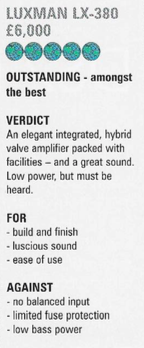
Phono stage equalisation was accurate, giving flat response from 10Hz to 20kHz with MM and MC. The Subsonic filter rolled off output below 100Hz, being -1d13 down at 50Hz and -17dB down at 5Hz — plenty enough to suppress LP warp signals. The Bass tone control, set to 150Hz turnover, compensated for subjective lightening of bass reasonably well when turned up by a very small amount; it has fine resolution.
Phono input sensitivity was very high, 2mV MM and 0.12mV MC being enough for full output. Overload was high at 85mV and 11 mV respectively and noise was also low at -82dB and -65dB respectively, the latter representing a superlow 0.07pV equivalent input noise.
The LX-380 measures well in all areas except bass power, where a limit of 8 Watts was out of keeping with all else. NK
From HiFi World Feb 2018

